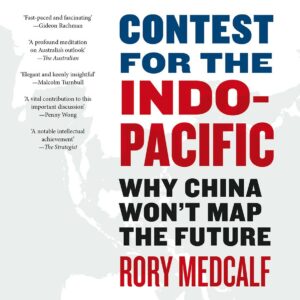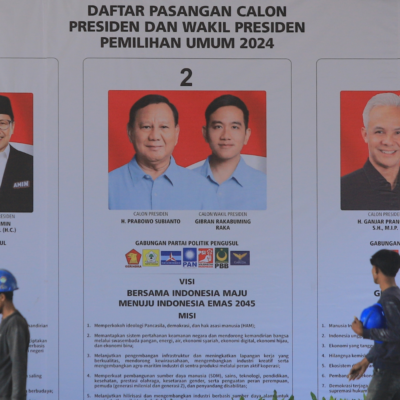
The publication of Contest for the Indo-Pacific in a revised and updated edition in 2022, following the original edition in 2020, is evidence of the book’s great topical importance. I have previously assessed the book (2020 edition) as one aspect of a review essay on China-Australian relations (Australian Journal of Politics and History, vol. 67, issue 3-4 (2021), published 17 January 2022), giving particular attention to the Indo-Pacific strategy advocated by the author as it relates to Australia. Here I would like to give an overall appraisal of the book, taking account of what has been added in the updated edition.
The book is not simply a work of advocacy. Before arguing for the relevance of an Indo-Pacific strategy as a means of countering ‘rising China’, Rory Medcalf provides a wide-ranging discussion of what the Indo-Pacific amounts to as a ‘region’. In the introductory chapter (chapter 1) the author argues that the term ‘Indo-Pacific’ focuses on ‘maritime Asia’; it draws attention to the connections between the Pacific and Indian Oceans, highlighted by China and India ‘rising together’. The focus on the Indo-Pacific has been stimulated by China’s ‘ascent’, manifested in the Maritime Silk Road of the Belt and Road Initiative; this is ‘the Indo-Pacific with Chinese characteristics’.
The first part of the book, entitled ‘Past’ (chapters 2-4) is a discussion of the Indo-Pacific in historical perspective, including more recent history. These chapters provide an excellent introduction to the Indo-Pacific viewed as a region. From an Indian Ocean perspective, the book connects to the field of Indian Ocean studies, a field that has been very much influenced by a ‘world history’ or ‘global history’ approach. The notes to the chapters enable the reader to delve further into this literature.
The second part of the book, entitled ‘Present’ (chapters 5-8) focuses on contemporary geopolitics in the Indo-Pacific. In chapter 6, Medcalf gives due attention to the roles of the three major powers (China, India, United States), but adds to the picture of complexity with his discussion of a range of other actors in chapters 6 (Japan, Australia, Indonesia, the countries of the Association of Southeast Asian Nations (ASEAN) generally, the two Koreas, Russia, the European countries (France in particular), small island states, the South Asian countries other than India, the Gulf states (as well as Islam more generally)). Chapter 7 covers economic issues in their political context (geoeconomics), while chapter 8 is about military and diplomatic interactions. Medcalf anticipates intense confrontations in the region; the existence of nuclear weapons means general war is less likely but paradoxically states can go further in attempting high level coercion. Multilateralism, for Medcalf, is only relevant at the edges.
The final part of the book, entitled ‘Future’ (chapter 9) is where Medcalf advocates an Indo-Pacific strategy as a way of countering ‘rising China’. In the first and second parts of the book he has argued for the relevance of thinking in terms of an Indo-Pacific construct. One could accept what he has articulated to this point without necessarily agreeing with the details of his preferred Indo-Pacific strategy (or one could accept some of the points but not necessarily all). In assessing China’s role Medcalf generally emphasises the ‘wolf warrior’ interpretation, growing Chinese assertiveness and concerns about China’s ability to ‘dominate’ in various contexts. To counter this his Indo-Pacific strategy involves thinking in terms of the Indo-Pacific construct, with all powers wishing to constrain China working together through various means. The Quad (US, Japan, India, Australia) is particularly important in this context, but there are many contexts and alignments (actual and possible) where the goal of constraining China can be pursued. Medcalf allows for at least some mutual interests between China and its competitors. The goal, for Medcalf, should be coexistence but essentially on terms where China’s competitors will be in a strong position.
For the updated 2022 edition the author has added a new introduction covering relevant developments in 2020-2021, including the AUKUS agreement between Australia, the United Kingdom and the US, COVID-19, ongoing challenges with China’s assertive diplomacy, changes in US engagement under the administration of President Joe Biden, and new developments affecting the middle powers of the region. Reviewing the argument in the light of these developments Medcalf writes that ‘the Indo-Pacific idea has emerged tempered and true’.
While one can allow for the relevance of the Indo-Pacific approach, at least in some contexts, there are also criticisms that need to be aired. Indo-Pacific is a convenient term if one is focusing on transoceanic affairs relating to both the Pacific and Indian Oceans. Unfortunately, however, the term avoids the word ‘Asia’; Indo-Asia-Pacific would be better in that respect. Although ‘Indo’ is meant to refer to the Indian Ocean, it is also the case that in general parlance ‘Indo’ is used as an adjective to denote India in hyphenated terms such as Indo-Australian relations. It is confusing if ‘Indo’ is taken to refer to India, with Indo-Pacific as a term thus privileging India. How would one respond to ‘Sino-Pacific’ as a broad regional term for (say) East Asia extending into adjoining parts of the Pacific Ocean? Given that strategic and broader political contexts can vary, there is no reason for not using Indo-Pacific (with the reservations noted) alongside other terms such as Asia-Pacific, East Asia, southern Asia, maritime Asia, Pacific region or Indian Ocean region, with the choice of term depending on the context.
On the specific question of the Indo-Pacific strategy as a preferred grand strategy for Australia and like-minded countries, the main issue is the way in which this strategy posits China as an adversary or at least a competitor of great and increasing strength. Most of the points presented as part of the strategy by Medcalf would be judicious as forms of soft balancing in relation to China, irrespective of seeing China as primarily an adversary. However, I would like to see more emphasis put on ways of engaging China, and this is not preeminent in the Indo-Pacific strategy (although nor is it absent). I prefer a broader strategy that allows for accommodation with China, while also enhancing the bargaining power of countries such as Australia in the various forms of engagement that are important. As between balancing and accommodation, it is not a matter of ‘either/or’; it can be ‘both/and’.
In relation to the update, Medcalf’s analysis is thoughtful. As a way of constraining China, it is soundly based, subject to the qualifications I have indicated. AUKUS ups the ante in relation to China; there are arguments in favour of putting more emphasis on accommodation not as an alternative but in conjunction with ‘soft’ balancing. The analysis might be unduly optimistic in relation to the future trajectory of the US, given the likely influence of Trumpism; strategies emphasising the role of middle powers need to allow for a possibly less supportive US. The introduction is prescient with its reference to Russia having a ‘capacity for disruption’ that is ‘vast’. The Ukraine crisis of early 2022, culminating in war, has huge implications for the Indo-Pacific, particularly in terms of its impact on China’s role. Whatever the specific developments in the crisis, China emerges as a strategic winner in that the US has to be prepared for major conflict not just with China, but also with Russia (not that there are not also costs to China—hence its preference for a diplomatic solution). We might also note India’s ambivalence over the Ukraine issue, an interesting development given the assumptions of the Indo-Pacific strategy. Does the shifting strategic pattern arising from the Ukraine conflict reinforce Medcalf’s argument or strengthen the position of those advocating accommodation with a ‘preeminent’ China (to use a term Medcalf suggests as a goal for the US in the Indo-Pacific)?
Image: Ships from the Royal Australian Navy, Indian navy, Japan Maritime Self-Defense Force and the United States Navy participate in Malabar 2020. Credit: US Navy/Wiki Commons.




